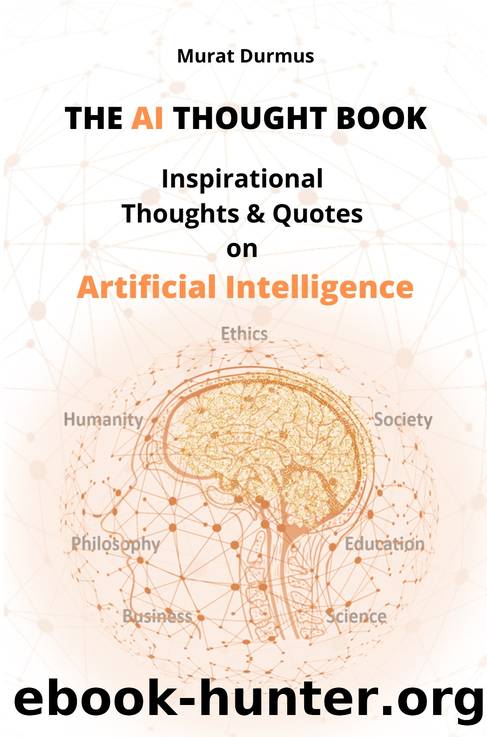THE AI THOUGHT BOOK: Inspirational Thoughts & Quotes on Artificial Intelligence (including 13 colored illustrations & 3 essays for the fundamental understanding of AI) by Durmus Murat

Author:Durmus, Murat [Durmus, Murat]
Language: eng
Format: epub
Published: 2021-03-14T16:00:00+00:00
* * *
4 https://ec.europa.eu/digital-single-market/en/news/ethics-guidelines-trustworthy-ai
Appendix 2: A brief history of Artificial Intelligence
Artificial intelligence (AI) is a growing discipline of sixty years that encompasses a range of sciences, theories, and techniques (including mathematical logic, statistics, probabilities, computational neurobiology, computer science and philosophy) that aim to mimic the cognitive abilities of humans. Its developments are closely related to those in computer science. They have resulted in computers being able to perform increasingly complex tasks that previously could only be assigned to a human.
However, this automation is still a long way from human intelligence in the strict sense, which has brought the term into criticism among some experts. The final stage of their research (a âstrongâ AI, i.e., the ability to contextualize very different specialized problems completely autonomously) is not comparable to current achievements (âweakâ or âmoderateâ AI, extremely efficient in its training domain). âStrongâ AI, which so far exists only in science fiction, would require advances in basic research (not just performance improvements) to be able to model the world as a whole.
Since 2010, however, the discipline has experienced a resurgence, mainly due to significant improvements in computer processing power and access to vast amounts of data.
Promises, renewed, and sometimes fantasized concerns complicate an objective understanding of the phenomenon. Brief historical recollections can help situate the discipline and inform current debates.
1940-1960: The birth of AI
The period between 1940 and 1960 was strongly marked by the combination of technological developments (whose accelerator was World War II) and the desire to understand how to bring together machines and organic beingsâ workings. For Norbert Wiener, a pioneer of cybernetics, the goal was to unite mathematical theory, electronics, and automation as âa whole theory of control and communication, both in animals and machines.â Shortly before, the first mathematical and computer model of the biological neuron (formal neuron) had already been developed in 1943 by Warren McCulloch and Walter Pitts.
John Von Neumann and Alan Turing did not create the term AI in early 1950, but they were the founders of the technology behind it: they made the transition from computers to 19th-century decimal logic (which thus dealt with values from 0 to 9) and from machines to binary logic (which is based on Boolean algebra and deals with more or less important chains of 0 or 1). The two researchers thus formalized our computersâ architecture today and showed that it is a universal machine capable of executing what is programmed. Turing, on the other hand, in his famous 1950 article âComputing Machinery and Intelligence,â first raised the question of the possible intelligence of a machine and described a âgame of imitationâ in which a human should be able to distinguish in a teletype dialogue whether he is talking to a human or a machine. As controversial as this article may be (the âTuring testâ seems to be out of the question for many experts), it is often cited as a source for questioning the boundary between humans and machines.
The term âAIâ could be traced back to John McCarthy
Download
This site does not store any files on its server. We only index and link to content provided by other sites. Please contact the content providers to delete copyright contents if any and email us, we'll remove relevant links or contents immediately.
Management Strategies for the Cloud Revolution: How Cloud Computing Is Transforming Business and Why You Can't Afford to Be Left Behind by Charles Babcock(4128)
Ego Is the Enemy by Ryan Holiday(3989)
Offensive Shellcode from Scratch by Rishalin Pillay(3646)
Exploring Deepfakes by Bryan Lyon and Matt Tora(3230)
Robo-Advisor with Python by Aki Ranin(2998)
Learning C# by Developing Games with Unity 2021 by Harrison Ferrone(2859)
Speed Up Your Python with Rust by Maxwell Flitton(2840)
Liar's Poker by Michael Lewis(2809)
Agile Security Operations by Hinne Hettema(2796)
OPNsense Beginner to Professional by Julio Cesar Bueno de Camargo(2795)
Linux Command Line and Shell Scripting Techniques by Vedran Dakic and Jasmin Redzepagic(2794)
Extreme DAX by Michiel Rozema & Henk Vlootman(2788)
Essential Cryptography for JavaScript Developers by Alessandro Segala(2733)
Elevating React Web Development with Gatsby by Samuel Larsen-Disney(2721)
AI-Powered Commerce by Andy Pandharikar & Frederik Bussler(2638)
Python for ArcGIS Pro by Silas Toms Bill Parker(2636)
Cryptography Algorithms by Massimo Bertaccini(2624)
Distributed .NET with Microsoft Orleans by Bhupesh Guptha Muthiyalu Suneel Kumar Kunani(2621)
Incident Response Techniques for Ransomware Attacks by Oleg Skulkin(2620)
